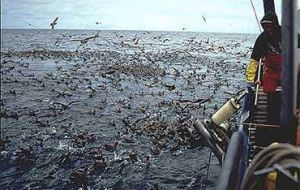MercoPress. South Atlantic News Agency
FAO urges industrial fishing strategies to protect seabirds
 Seabirds flocking at a longliner
Seabirds flocking at a longliner Following the success of strategies to protect seabirds from longline fishing activities, the United Nations Food and Agriculture Organization (FAO) has urged regions using other industrial fishing techniques, such as trawl nets and gillnets, to implement safeguards in areas where seabirds are at greatest risk.
The threat of fishing on populations of already endangered seabirds – including albatrosses, of which 18 of the 22 species are listed as endangered – can be curbed by joint action, FAO has suggested. "With industry and government working as partners, the impacts of fishing can be greatly reduced," said Francis Chopin, a senior fishery officer with FAO. The practice of longline fishing, which involves boats trailing long lines bearing as many as 2,500 baited hooks, threatens seabirds that follow the vessel and dive for the bait, and in the absence of safeguards become hooked. In case of trawling, the trailing of cone-shaped nets behind boats, large birds such as petrels and albatrosses are unable to maneuver out of the way of the fishing wires, while with the use of gillnets diving birds can become entangled in the long line of netting following the vessel. Statistics reported to FAO have indicated a significant decrease in collateral damage to seabirds worldwide in areas where safeguards to lessen the impact of longline fishing have been implemented. The number of birds killed as a result of Chilean longline fishing dropped from 1,600 in 2002 to zero in 2006, while the number in the Southern Ocean around Antarctica was reported to have fallen from 6,500 in 1996 to zero last year. Following an expert consultation earlier this month that was organized by the UN agency in Bergen, Norway, best practice guidelines have been outlined that work to extend the International Plan of Action (IPOA) approach – a framework developed by FAO and approved by member countries in 1999 – to include trawl and gillnet fisheries in areas of high seabird density. The 10 countries currently implementing, or in advanced stages of preparing, strategies to lessen the impact of fishing on seabirds are South Africa, Australia, Chile, Canada, Brazil, Japan, Uruguay, Argentina, Namibia and the United States.




Top Comments
Disclaimer & comment rulesCommenting for this story is now closed.
If you have a Facebook account, become a fan and comment on our Facebook Page!